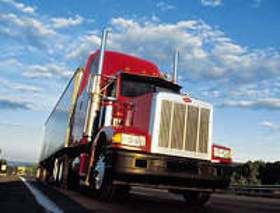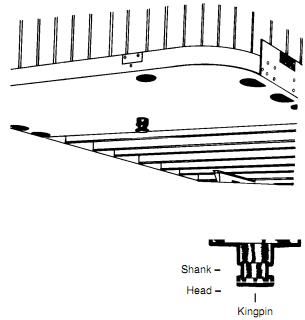Review Questions - Click On The Picture To Begin...

All of the following are good ways to inspect the tractor and trailer coupling, except:
- Go under the trailer and look into the back of the fifth wheel to be sure the trailer king pin is properly secured in the fifth wheel locking jaws
- Check to make sure there is about 3 to 6 inches of space between the fifth wheel plate and the trailer
- Be sure the safety latch is in position over the locking lever
- Raise the trailer landing gear slightly off the ground and pull the tractor gently forward with the trailer brakes set to be sure you are connected
Quote From The CDL Manual:
Check Connection For Security
- Raise trailer landing gear slightly off ground.
- Pull tractor gently forward while trailer brakes are still locked to check that the trailer is locked onto the tractor.
Secure Vehicle
- Put transmission in neutral.
- Put parking brakes on.
- Shut off engine and take key with you so someone else will not move truck while you are under it
Inspect Coupling
- Use a flashlight if necessary.
- Make sure there is no space between upper and lower fifth wheel. If there is space, something is wrong (kingpin may be on top of closed fifth wheel jaws; trailer would come loose very easily).
- Go under trailer and look into the back of the fifth wheel. Make sure the fifth wheel jaws have closed around the shank of the kingpin.
- Check that locking lever is in the "lock" position.
- Check that safety latch is in position over locking lever. (On some fifth wheels, the latch must be put in place by hand.)
- If the coupling is not right, do not drive the coupled unit; get it repaired
Next
How far should the trailer landing gear be raised?
- All the way up
- On light loads, only half way but on heavy loads, it should be raised all the way up
- 3/4 of the way up
- Half way up
Quote From The CDL Manual:
Raise The Front Trailer Supports (Landing Gear)
- Use low gear range (if so equipped) to begin raising landing gear. Once free of weight, switch to the high gear range.
- Raise landing gear all the way up. (Never drive with landing gear only part way up, as it may catch on railroad tracks or other things.)
- After raising landing gear, secure crank handle safely.
- When full weight of trailer is resting on tractor:
- Check for enough clearance between rear of tractor frame and landing gear. (When the tractor turns sharply, it must not hit landing gear.)
- Check that there is enough clearance between the top of the tractor tires and the nose of the trailer
Prev
Next
How much space should be visible between the upper and lower fifth wheel?
- There should be 1 to 2 inches of space visible
- There should be 2 to 4 inches of space visible
- There should be space visible, but it should be less than 1 inch
- There should be no space visible
Quote From The CDL Manual:
Inspecting Coupling
- Use a flashlight if necessary.
- Make sure there is no space between upper and lower fifth wheel. If there is space, something is wrong (kingpin may be on top of closed fifth wheel jaws; trailer would come loose very easily).
- Go under trailer and look into the back of the fifth wheel. Make sure the fifth wheel jaws have closed around the shank of the kingpin.
- Check that locking lever is in the "lock" position.
- Check that safety latch is in position over locking lever. (On some fifth wheels, the latch must be put in place by hand.)
- If the coupling is not right, do not drive the coupled unit; get it repaired.
TruckingTruth's Advice:
No space should ever be visible between the fifth wheel plate and the trailer. Be sure you visibly inspect the fifth wheel, as well as the king pin and locking jaws every time you hook to a new trailer. It's also a great idea to get into the habit of pulling against the trailer by leaving the trailer brakes on and slightly tugging on the trailer. This will help insure that you are properly connected. Dropped trailers are very common in the trucking industry, simply because drivers become lazy and don't visually check the truck / trailer connection.
Prev
Finish
Please select an option









 TT On Facebook
TT On Facebook